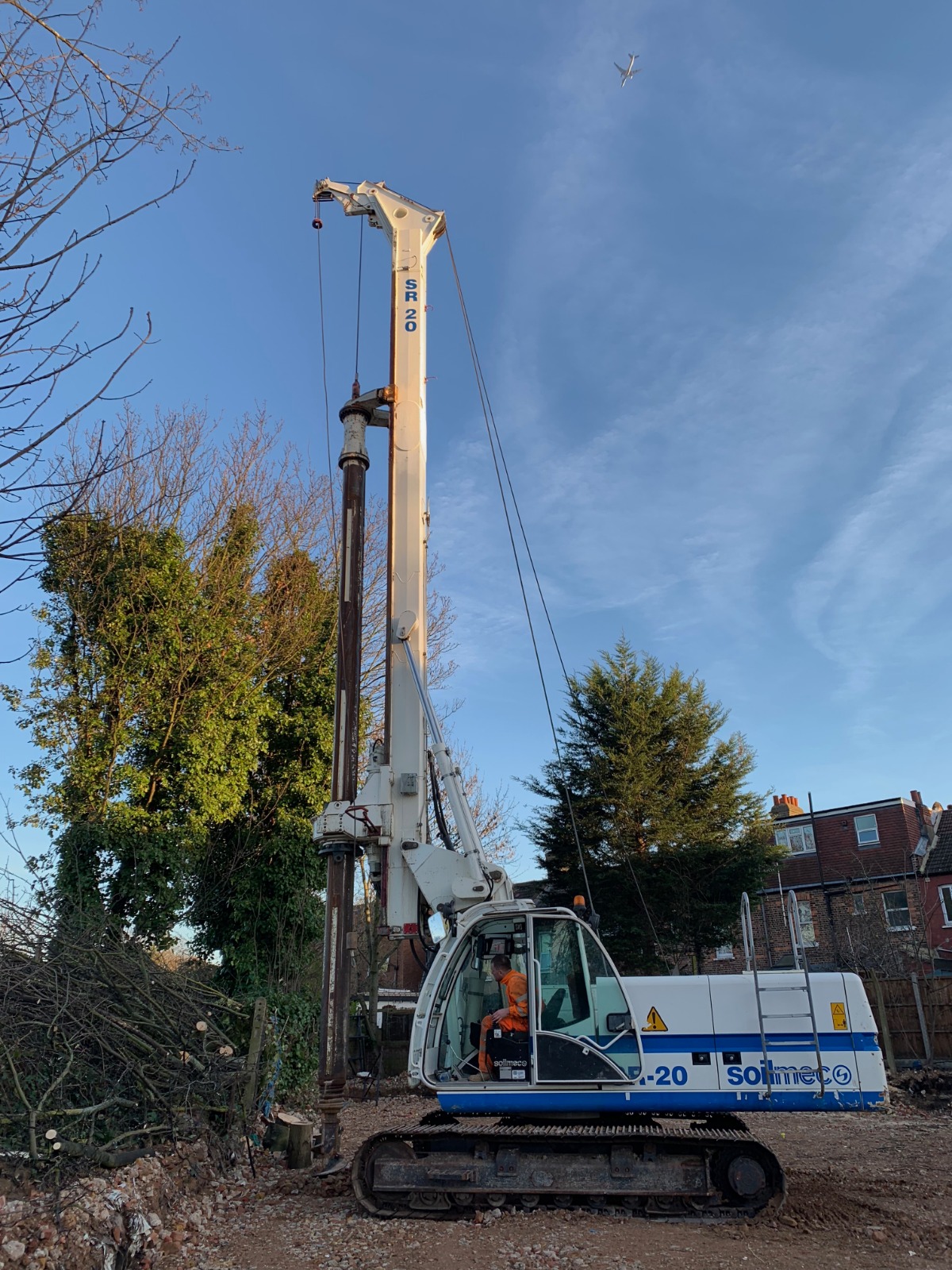Rotary Bored Piling in London – Deep and Reliable Foundation Solutions
At KHB Piling LTD, we specialise in rotary bored piling services across London and the South East, providing robust, low-vibration deep foundations for both commercial and residential construction.
Rotary bored piling – also called rotary bored auger piling (RBP) – is one of the most advanced techniques for installing deep foundations in variable or challenging ground. It allows us to drill through clay, gravel, chalk, or rock while maintaining full control over diameter, depth, and alignment.
Our rigs can form piles from 450 mm up to 2,500 mm diameter, reaching depths of over 30 m where required. This makes rotary bored piling ideal for infrastructure, high-rise buildings, basements, bridges, and any structure that demands high load capacity and long-term stability.
What Is Rotary Bored Piling?
Rotary bored piling is a technique that uses a rotating auger to excavate soil and form a borehole which is then reinforced and concreted to create a pile. It is a slow-rotation, high-torque process that offers precision and minimal vibration – essential in dense urban environments like London.
Unlike driven piling, which can cause ground heave or vibration, rotary bored piling is quiet and safe near existing buildings and tunnels. It’s the preferred method for complex or sensitive projects, particularly where ground conditions vary layer by layer.
How the Rotary Bored Piling Process Works
Our engineer-led process ensures every pile meets design requirements for load, alignment, and depth.
- Ground Investigation & Design – We review borehole logs and soil reports to define the optimal pile type, diameter, and depth, in line with BS EN 1536:2010 +A1:2015.
- Setting Out & Pre-Drilling – Each pile position is marked precisely to match structural drawings.
- Borehole Drilling – The rotary rig drills down using a continuous or segmental auger. For unstable soils, a temporary casing may be inserted.
- Cleaning & Inspection – We inspect the bore for stability and remove debris to ensure a clean shaft before concreting.
- Reinforcement & Concreting – A steel cage is placed and high-strength concrete is tremied into the borehole, forming a monolithic, high-capacity pile.
- Testing & Records – We perform integrity and load tests and supply full documentation for Building Control and the structural engineer.
Each phase is recorded digitally for traceability and compliance. This systematic approach is what distinguishes KHB from generic piling contractors.
Where Rotary Bored Piling Excels
Rotary bored piling is extremely versatile and suited to a wide range of applications:
- Large buildings and tower blocks – capable of supporting heavy column loads and raft slabs.
- Bridges and transport infrastructure – deep foundations with high axial and lateral capacity.
- Basements and retaining walls – contiguous and secant bored pile walls to retain soil and resist water pressure.
- Industrial foundations – heavy plant bases and storage facilities.
- Residential developments – suitable where existing ground is weak or mixed fill is present.
Advantages of Rotary Bored Piling
- Deep capacity – handles loads up to several thousand kN per pile.
- Works in almost all ground types – including cohesive clay, sand, gravel, chalk and rock.
- Minimal vibration and noise – essential for dense residential or historic areas.
- Precise verticality and alignment – critical for tall or sensitive structures.
- Integration with basement walls – can be used to create retaining walls or combined with capping beams.
Limitations and Considerations
While rotary bored piling is exceptionally strong and adaptable, it requires sufficient headroom and working space for the rig, and a stable working platform. It is generally not the most economical solution for very small domestic sites, where mini piling or CFA piling may be more suitable.
Our engineers will always advise which system provides the best technical and financial outcome for your project.
Rotary Bored vs CFA Piling
| Feature | Rotary Bored Piling | CFA Piling |
|---|---|---|
| Vibration | Very low | Low |
| Maximum Depth | 30 m + | ~20 m |
| Maximum Diameter | Up to 2.5 m | Typically 900 mm |
| Ground Type | Clay, gravel, rock, mixed | Clay and sand |
| Access Requirement | High – large rig | Moderate |
| Typical Use | Infrastructure, basements, bridges | Residential and medium buildings |
Quality Assurance and Testing
All rotary bored piles installed by KHB are tested and certified. Our in-house QA process includes:
- Concrete cube and slump testing.
- Dynamic or static load tests on selected piles.
- Integrity testing (PIT) after curing.
- Detailed pile logs, concrete volumes and as-built drawings.
These records ensure full traceability and client confidence for warranty and Building Control sign-off.
Environmental and Safety Commitment
We use modern, low-emission rigs equipped with noise suppression and dust-control systems. All operations follow HSE construction guidance and BS EN 1536 to maintain the highest safety standards on site.
Engage KHB Piling for Rotary Bored Piling in London
If you need dependable rotary bored piling contractors in London, contact KHB Piling LTD. We provide free initial consultations, cost estimates, and design input to help engineers and developers get the best foundation solution.
Call +44 7821 836407 or email info@khb-piling.co.uk to discuss your project.
Related Services
- CFA Piling – continuous flight auger piling for medium-depth foundations.
- Mini Piling – cost-effective solutions for restricted-access sites.
- Basement Construction – underpinning, retaining walls and waterproofing packages.
- Project Gallery – examples of our piling and foundation work across London.

